59th Evacuation Hospital Unit History
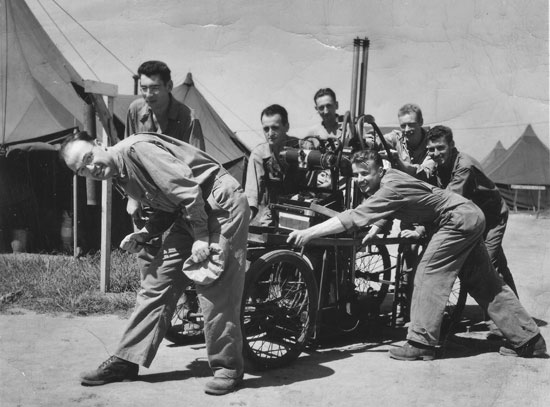
Several members of the 59th Evacuation Hospital move a Portable X-Ray Machine (Item No 6090000) during the unit’s time somewhere in the MTO.
Activation & Early History:
The 59th Evacuation Hospital was activated on 6 April 1942 as a 750-bed unit. The majority of its Medical Officers were drawn from the San Francisco Hospital, San Francisco, California. It was at this time that Col. Oral B. Bolibaugh, M.C. assumed command of the unit. Upon activation, the unit was stationed at Fort Lewis, Tacoma, Washington (AGF Training Camp) as part of the Fourth United States Army, attached to IX Corps for Administration. On 2 May 1942 the unit left Fort Lewis by rail for Fort Ord, Monterey, California (AGF Training Area); providing a permanent change of Station. When at Fort Ord, the unit was re-attached to VII Army Corps and 3d Infantry Division for administration. During the ensuing months, Nurses reported for duty, and training programs for all personnel were established. Effective on activation, 36 Medical Officers of the affiliated group arrived, followed by 221 trained Enlisted Men from the 68th Evacuation Hospital (Ft. Lewis, Washington) and subsequently 100 EM from the 202d General Hospital were assigned to the organization. The 52 ANC Officers were obtained mainly by direct appointment. 1 Chaplain, 3 DC Officers, 1 QMC Officer, 6 MAC Officers, and 1 Dietitian composed the remainder of the staff. In addition to the above personnel, the unit was assigned 2 American Red Cross workers.
On 11 August 1942 the unit was once again on the move by rail, this time for an unidentified Port of Embarkation. Five days later the unit arrived at Camp Kilmer, Stelton N.J. (Staging Area for New York P/E), where it was learned that official plans had changed and the unit was to go to Camp Pickett, Blackstone, Virginia. The move took place on 21 September 1942, and the unit became attached to the Second United States Army for Administration and Supply. At Camp Pickett, training programs continued as before, and all equipment was packed and crated in preparation for shipment overseas.
After returning to Camp Kilmer on 23 November 1942 and completing processing for overseas duty, the unit and equipment were sent to the New York Port of Embarkation in preparation for the unit’s first overseas duty. The unit boarded the USAT “Uruguay” on 11 December 1942. The unit set sail a day later for Casablanca, French Morocco, and disembarked there on 24 December. During its early stages in Casablanca, the unit acted as a Convalescent Hospital attached to the Western Task Force. However, patient flow soon saw the status of the Hospital upgraded to that of a Station Hospital, with an extra compound being constructed to handle PW patients.
The unit continued to operate in the area, working alongside other Station Hospitals in the region operating a Venereal Disease Stockade and a temporary PW Hospital. The Hospital was assigned to the Fifth United States Army and temporarily attached to the Western Task Force, in fact acting more as a Convalescent Hospital, which eventually evolved to a Station Hospital. The 1st Medical Hospital Ship Platoon was attached from 10 March 1943 onwards to operate the VD stockade and the 4th Medical Hospital Ship Platoon was attached on 9 April 1943 to help with the increasing patient load. Both units were released 4 May 1943. On 20 May, the organization was assigned to the 1st Armored Corps under the jurisdiction of the Atlantic Base Section (ABS). On 17 June 1943, 11 Medical Officers and 23 Enlisted Men were placed on Detached Service to serve as medical personnel with the US Navy for the landing operations on the south coast of Sicily (Operation HUSKY -ed). However, towards the end of June, patient load had diminished significantly, and the Hospital was barely operating the basic Administrative Section.
1943 Admissions – US Personnel & Allies (Casablanca, French Morocco)
January – 282 patients (of which 4 battle casualties)
February – 478 patients (of which 0 battle casualties)
March – 1337 patients (of which 0 battle casualties)
April – 1025 patients (of which 19 battle casualties)
May – 843 patients (of which 0 battle casualties)
June – 26 patients (of which 0 battle casualties)
1943 Admissions – Enemy Prisoners of War (Casablanca, French Morocco)
March – 44 (all battle casualties)
April – 246 (of which 224 battle casualties)
Operations in the MTO:
After receiving alert orders, the unit sent an advance party of 4 Officers and a number of EM to Algiers. The following day, 19 July 1943, the remaining personnel departed by rail and motor convoy in two groups; a first echelon consisting of 12 Officers, 52 Nurses, and 188 Enlisted Men went by train, and a second group consisting of 20 Officers and 88 EM traveled by motor convoy. The 59th Evac Hosp was supposed to be relocated to Algiers, Algeria.
However, enroute to its new location, revised orders were received and the organization was re-directed to Bizerte, Tunisia. This area was used as a restaging and regrouping area, and orders were received on 1 August 1943 for the movement of the unit, by water, to an unknown location. At 0600, 3 days later, the Hospital departed in three echelons from Bizerte Harbor, Tunisia to Palermo, Sicily. Debarkation took place at 1600, 6 August 1943. Due to attack from enemy aircraft during repairs, an LST carrying Hospital supplies had been delayed. Since patients were scheduled to arrive in 2 days, Officers and EM alike set to work to convert a group of bombed buildings (formerly the University of Palermo Polyclinic) into a suitable Hospital, ready to receive patients.

Illustration showing the x-ray facilities at the 59th Evacuation Hospital during the unit’s time at Palermo, Sicily.
1943 + 1944 Admissions – US Personnel & Allies (Palermo, Sicily)
August – 3187 patients (of which 173 battle casualties
September – 3135 patients (of which 43 battle casualties)
October – 2707 patients (of which 114 battle casualties)
November – 1746 patients (of which 12 battle casualties)
December – 985 patients (of which 28 battle casualties)
January – 875 patients (of which 2 battle casualties)
February – 709 patients (of which 1 battle casualty)
March – 1008 patients (of which 43 battle casualties)
April – 717 patients (of which 0 battle casualties)
May – 10 patients (of which 0 battle casualties)
1943 Admissions – Enemy Prisoners of War (Palermo, Sicily)
September – 33 patients (of which 10 battle casualties)
October – 10 patients (of which 10 battle casualties)
The remaining Hospital equipment and staff were received on 9 August, which meant more buildings could be converted into Wards, and staffed as such. The unit continued operation in this facility, with an average daily patient flow varying from 800 to 1,100. During these early stages, the 59th Evac acted mainly as a holding Hospital, evacuating any patients that were unable to be returned to duty within 10 days. While in Sicily, the majority of the 20,000 incoming patients were treated for a cross section of conditions; jaundice, malaria, dysentery, paratyphoid and typhoid fever. During the final days of the Sicilian campaign, the 59th Evac Hosp also served to evacuate many of the battle casualties.
During the opening days of May, 1943 it was realized that the unit’s presence as a 750-bed Hospital Unit was no longer required. As a result, on 5 May, the remaining 122 patients and the buildings in which the 59th had been operating were handed over to the 154th Station Hospital. For the time being, equipment was repacked in preparation for further movement, and recreation schemes and programs were instigated for the Hospital staff.
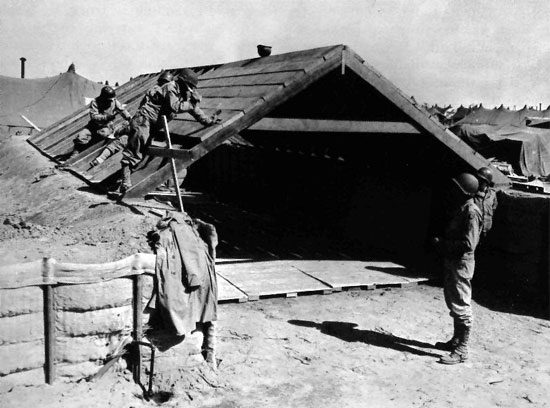
Somewhere on the Anzio Beachhead, protecting Operating Tented Wards with 2-inch wooden planks and sandbags. Because of German air raids and the rising tempo of long-range shelling, there was in fact no safe area on the Beachhead! Huge enemy railway guns, such as “Whistling Willie” and “Anzio Express” were trained on the beach area from concealed positions, and there was no other alternative except dug in. Most Hospitals stood only 6 miles away from the front lines and were backed against the sea, there simply was no other site to move to. In the end, excavations of 3 to 4 feet deep, earth revetments of 3 1/2 feet thick, steel stakes, chicken wire, wooden planks, and plenty of sandbags were used to provide additional protection for patients and medical personnel.
Movement orders were received by the unit on 24 May 1944, and the following day the first echelon of 3 Officers, 34 Nurses, and 12 EM departed by Liberty Ship for an area near to Naples. The remainder of the unit left for Naples on 28 May. Upon arrival in Naples, the first complement of Officers and Enlisted Men were billeted in Officers’ quarters and the 27th Evacuation Hospital bivouacs respectively. The second group comprising 43 Officers, 13 Nurses, 1 Dietitian, 2 ARC workers, and 291 Enlisted Men departed on 28 May. When the remainder of the unit arrived in the area (29 May 1944) they proceeded to Sessa, Italy where the personnel and staff was bivouacked with the 616th Medical Clearing Company. The following day, 40 Nurses were placed on Detached Service with various Hospitals in the area, while the Officers and Enlisted Men of the Second Echelon joined the First in bivouac. Unit equipment was sent to the Sessa area by train in preparation for the forthcoming operations.
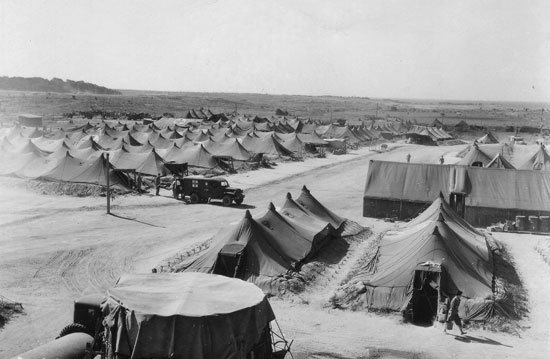
Partial view of the tented Hospital facilities on Anzio Beachhead. Note how the Ward Tents have been dug into the ground in an effort to provide enhanced protection against enemy shelling. Combat troops and medical personnel shared all the discomfort, the inconvenience, and personal hazards of the Beachhead, and yet carried on with daily routine.
On 1 June 1944, the 884th Medical Collecting Company was attached to the 59th Evac Hosp for rations, quarters and duty (as per SO 153, Para 11, Hq PBS). This attached unit was relieved of duties 13 days later. On 5 June 1944 the unit had completed its move to Anzio (operational 7 June > 10 July) and its staff once again went into bivouac, this time close to the 38th Evacuation Hospital, a unit it was to relieve 2 days later. Nurses returned to the 59th Evac Hosp during this time from Detached Service. During its time the unit served mainly to evacuate patients via plane to General Hospitals in the Naples area. This action continued into the first ten days of July.
1944 Admissions – US Personnel & Allies (Anzio Beachhead, Italy)
7 June 1944 > 10 July 1944 – 1726 patients (of which 209 battle casualties)
10 July 1944, movement orders were received, and preparation of the Hospital’s equipment and personnel was completed 4 days later when the unit arrived at Paestum, Italy (beside 4 Officers and 18 EM who remained in the Naples area for Clearance). While in Paestum the unit bivouacked with the 32d Field Hospital, and on 15 July the unit relieved the 32d Fld Hosp of its site and 1,153 patients. Regular Hospital activities were reconvened and on 18 July, the staff that had remained in Naples for Clearance returned, bringing the Hospital’s personnel and equipment up to T/O strength. In preparation for relocation, the Hospital evacuated all current patients, or transferred them to the 154th Station Hospital. The unit remained in the area for the rest of the month, with the staff bivouacking and packing all the equipment for movement. On 29 July, 5 Surgical Technicians were placed on TD with the 10th Field Hospital.
1944 Admissions – US Personnel & Allies (Paestum, Italy)
6 July 1944 > 27 July 1944 – 2115 patients (of which 5 battle casualties)
While the 59th completed packing and consolidating crates and boxes preparatory to any movement, one surgical team composed of 4 Officers and 3 Surgical Technical was set up for TD with the 93d Evacuation Hospital.
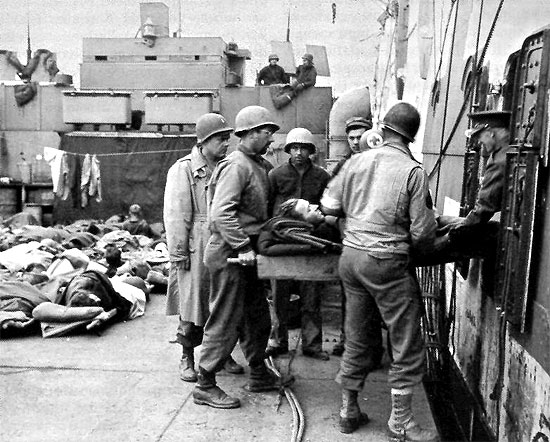
Wounded soldiers are being transferred from an LCI to one of the 3 British Hospital Ships off Anzio. The 52d Med Bn (Sep) set up a Collecting-Clearing Station to receive casualties from the Aid Stations and evacuate them to the ships. Evacuation was from the beach until the harbor became available and operational on 29 Jan 44; meanwhile, LCIs and smaller craft were the only means to evacuate patients to LSTs or Hospital Ships offshore…
On 11 August 1944, as per V.O. Commanding General, Seventh US Army, all Hospital Nurses, Dietitians and ARC workers were sent to the Naples Staging Area. Various unit organization changes took place in the days which followed, and by 13 August, 1944, the movement from Paestum back to Naples was complete. Personnel were brought back to near T/O strength by receipt of 2 MC Officers, 7 Nurses and 9 EM from Replacement Centers. These Replacements were necessary due to loss through transfers to other units and hospitalization.
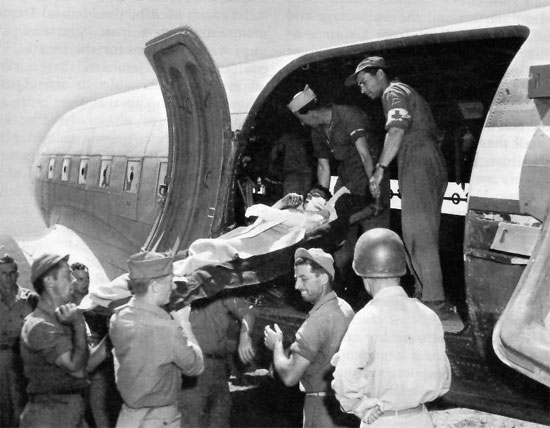
Air Evacuation was one of the means to transfer patients from Fifth US Army Hospitals to fixed PBS medical installations in Caserta, Naples, and Rome. The aircraft were operated by the 802d + 807th Medical Air Evacuation Transport Squadrons (MAETS).
Transfer & Operations in the ETO:
At 1000 hours 20 August 1944, the 59th boarded L.S.T. #4 at Nisida, bound for St. Tropez, France, where it landed on 25 August (together with the 9th Evac and 51st Evac Hosp). Upon debarkation, personnel were bivouacked at the Staging Area in Ste. Maxime. Personnel and equipment remained in Ste. Maxime for a further 7 days, at which point the whole outfit was moved by convoy to Carpentras, France. The unit established a functioning Hospital near the site to be vacated by the 3d Inf Div’s Clearing Station on 28 August 1944 and received its first patient at 1300 on that same day. This was the first time in its overseas service that the 59th had functioned as a true Evacuation Hospital (i.e. receiving battle casualties from Collecting Companies and patients from Field Hospitals for evacuation). Due to the rapid advance of troops, however, the unit’s duration here was short, and as a result the Hospital was closed on 5 September 1944, after taking in 611 patients and performing 222 surgical procedures.
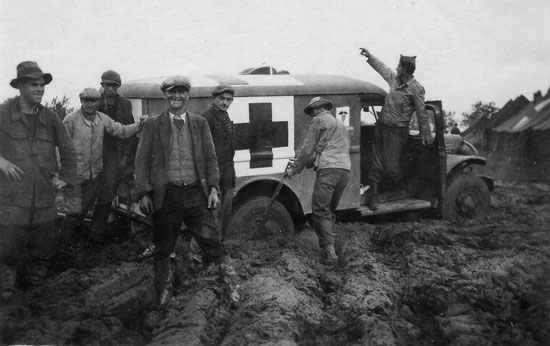
This illustration demonstrates the poor conditions in which the 59th Evac Hopsital operated in the area of Rioz, France. Despite access roads having been gravelled, incoming vehicles often stalled and had to be dug out by Hospital personnel and locals.
1944 Admissions – US Personnel & Allies (Carpentras, Southern France)
28 August 1944 > 5 September 1944 – 434 patients (of which 142 battle casualties)
1944 Admissions – German Prisoners of War (Carpentras, Southern France)
28 August 1944 > 5 September 1944 – 137 patients (of which 124 battle casualties)
On 13 September 1944 the unit packed and prepared equipment for transportation, and embarked upon a 310-mile journey to Rioz, Haute Saône, France. Due to the scale of the move, trucks were drafted in from a number of different units, and Ambulances from the 599 Medical Collecting Company (which had been servicing the unit during its time at Carpentras) were used to transport troops to the new location. The complete unit reached its destination on 19 September, having left 1 Officer and 2 EM behind for Clearance. The unit initially set up on 17 September, and received its first patient at approximately 1200 hours. The Hospital was fully operational from the 19th, and remained so for a further 21 days. Weather conditions in Rioz had made roads around and through the Hospital complex almost impassable, and this proved difficult for the Receiving section, due to the frequent stalling of Ambulances and trucks. In addition, all ambulatory patients were fed in Wards, as opposed to venturing to the Mess. Continuous rain and cold hampered Hospital movements, consequently all tents had to be ditched, access roads graveled, and tent pegs periodically reset in the soft grounds, heating facilities were often inadequate to keep patients warm. On 30 September, orders were received from the Surgeon’s Office, Seventh US Army to close the Hospital as of 1400 hrs. All remaining patients were evacuated by train and air two days later (2 October 1944).
1944 Admissions – US Personnel & Allies (Rioz, France)
17 September 1944 > 30 September 1944 – 1219 (of which 343 battle casualties)
1944 Admissions – German Prisoners of War (Rioz, France)
17 September 1944 > 30 September 1944 – 148 patients (of which 142 battle casualties)
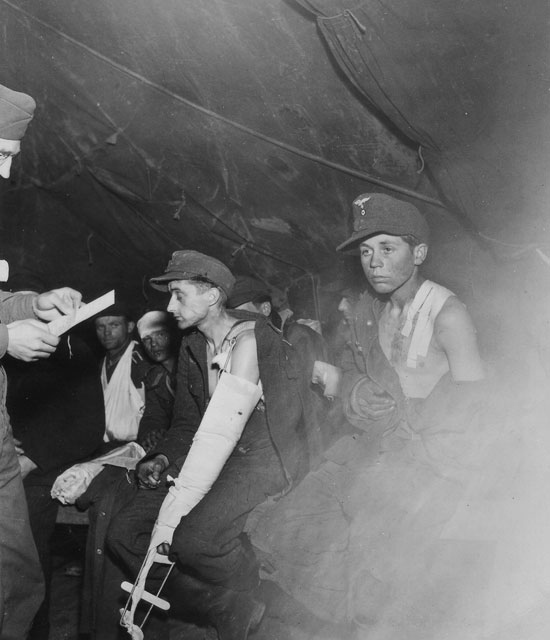
Young German soldiers are treated for their wounds by members of the 59th Evacuation Hospital. The photograph is believed to have been taken during the unit’s operations in France.
The movement and preparation of Hospital staff and equipment to Epinal, Vosges was completed on 5 October 1944. In this area, the Hospital occupied buildings pertaining to the French Military Hospital of Golbey (which had previously been a German-occupied and staffed Hospital since the Occupation). The buildings provided sufficient space for a maximum of 900 beds, with one group of buildings being equipped as Operating Rooms. During this time, the Hospital was located no more than 15 miles from the front, and thus battle casualties arrived quickly from the Clearing Stations, usually only within a matter of hours. Casualties in this area were drawn mainly from the 3d, 36th, 45th and 79th Infantry Divisions, with a number of German PWs also being treated. It was during the 59th’s time in Epinal that a visit to the Hospital was made by Lieutenant General Alexander M. PATCH (CO > Seventh US Army) and Lieutenant General Jacob L. DEVERS (CO > 6th Army Group).
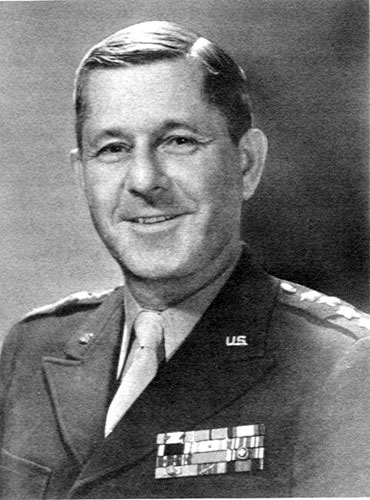
Portrait of Lieutenant General Jacob DEVERS, Commanding Officer, 6th Army Group. Devers visited the unit during its time in Epinal, Vosges.
The Hospital continued operating at Epinal during the entire month of November, being officially closed on the last day of the month, with the remaining 327 patients being either evacuated or transferred to the 35th Station Hospital, which had taken over the building upon the 59th’s departure. This proved a very busy period for the Hospital staff, with total admissions over the month amounting to 4,431. Seven Surgical Teams were kept constantly busy, each working on 12-hour shifts. The most common causes of admission for the Medical Service were trench foot, common respiratory disease and fevers. During this period, admissions were controlled by the Commanding Officer of the 52d Medical Battalion (Separate) depending upon surgical backlog and the number of available beds. Patients were typically evacuated to the 58th Medical Battalion (Separate), for which a separate Ambulance Platoon had been attached, or to the 21st General Hospital. Minor cases were evacuated to the smaller 2d Convalescent Hospital (at Besançon). Patient flow in this area demanded more nursing staff, and so a further 37 Nurses were attached for temporary service from various other units:
- 116th Evacuation Hospital (2 Nurses)
- 117th Evacuation Hospital (7 Nurses)
- 132d Evacuation Hospital (13 Nurses)
- 23d Station Hospital (15 Nurses)
1944 Admissions – US Personnel & Allies (Epinal, France)
5 October 1944 > 30 November 1944 – 7417 patients (of which 1308 battle casualties)
1944 Admissions – German Prisoners of War (Epinal, France)
5 October 1944 > 30 November 1944 – 452 patients (of which 357 battle casualties)
Upon the Hospital’s closure in this area on 30 November, the Nurses were returned to their units. The end of the month was largely spent in preparation for another move.
When the Hospital officially ended operations in Epinal, 503 patients remained for Clearance, a process which was to take an additional 6 days, with the majority being returned to duty, or transferred to other Hospital units in the vicinity. The unit was then ordered to a new site at Mutzig, Alsace. Here, the unit was to occupy a French Caserne, comprising two large four-storied buildings. These buildings provided sufficient space for barracks and the Hospital proper. The first echelon of personnel arrived at Mutzig on 5 December 1944 with the main aim to prepare and make ready the buildings. Once again the Caserne had been occupied by the Germans, and they had been left in unsatisfactory condition for a Hospital! All remaining personnel and equipment arrived at the location on 8 December, and the Hospital was officially opened on this date. The Hospital operated at this site until 30 December, when during the night of 30 – 31 December 1944, it moved back to Epinal to occupy Military Barracks in the vicinity of its former site. This step was taken mainly due to the uncertainty of the military situation during the last days of the month.
1944 Admissions – US Personnel & Allies (Mutzig, France)
8 December 1944 > 30 December 1944 – 1962 patients (of which 726 battle casualties)
1944 Admissions – German Prisoners of War (Mutzig, France)
8 December 1944 > 30 December 1944 – 205 patients (of which 127 battle casualties)
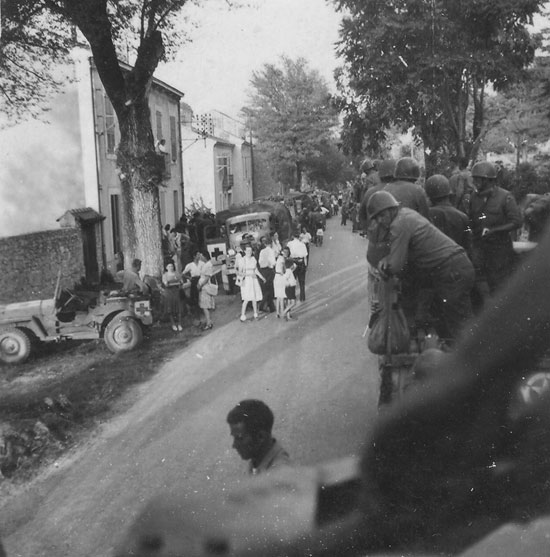
Members of the 59th Evacuation Hospital entrucked during the unit’s move to Rioz, Haute Saône. Note the assortment of Red Cross symbols applied to 1/4 Ton and 2-1/2 Ton Trucks.
Upon arrival back in Epinal, preparations were being made for the 236th General Hospital to operate from that location. However some buildings were handed over to the 59th Evac Hosp, and the unit reopened from this location on 1 January 1945. It continued in operation until 2400 hours on 23 January 1945. During this period the Hospital made 1,081 admissions. Upon closure of the Hospital, the remaining 412 patients were transferred to the neighboring Hospital. The unit remained inactive for the rest of January 1945, with only a limited number of personnel being transferred to other units for Temporary Duty. Assignments included: 1 Officer sent to the 2d Auxiliary Surgical Team on 18 January 1945; 2 Nurses attached to the 57th Field Hospital the same day; 4 Officers, 2 Nurses, and 8 Enlisted Men attached to the 51st Evacuation Hospital on 25 January 1945; 4 Officers, 6 Nurses, and 19 EM to the 95th Evacuation Hospital on 26 January 1945.
The unit continued to be inactive through the beginning of the new year, into February 1945 (from 23 January until 28 February 1945). During this time, Officers from the unit traveled round various Hospitals in the Communication Zone tracking patient status and inspecting the work of these organizations. A number of Officers and Nurses were assigned to Temporary Duty with other units, but the time was mainly used as R&R for the Enlisted personnel. A group of 15 Officers and 12 Nurses were assigned on TD to the 5th and 97th General Hospitals, the 23d Station Hospital, and the 27th, 51st, and 93d Evacuation Hospitals. During the first weeks of March, the Hospital was inactive remaining billeted in the Military Barracks at Golbey.
1945 Admissions – US Personnel & Allies (St. Avold, France)
16 March 1945 > 24 March 1945 – 794 patients (of which 302 battle casualties)
1945 Admissions – German Prisoners of War (St. Avold, France)
16 March 1945 > 24 March 1945 – 79 patients (of which 57 battle casualties)
The unit was alerted on 14 March 1945, and a first group of personnel secured a site near to St. Avold (97 miles north-east of Epinal), with the remaining staff and equipment arriving on 16 March. By 2330 hrs of the same date, the Hospital opened and began to receive patients. This was the first operation of the Hospital in a tented facility since October 1944. Once again due to rapid troop movement, the Hospital was already closed in this area on 24 March 1945, having admitted 875 patients during its 7 days of operation. A new site was located 88 miles from St. Avold near Grünstadt, Germany (Tiefenthal), and on 26 March at 1900 hrs the Hospital had reopened. The organization continued operations here for the remainder of March.
1945 Admissions – US Personnel & Allies (Tiefenthal, Germany)
26 March 1945 > 31 March 1945 – 641 patients (of which 187 battle casualties)
1945 Admissions – German Prisoners of War (Tiefenthal, Germany)
26 March 1945 > 31 March 1945 – 101 patients (of which 75 battle casualties)
The unit continued operations in Tiefenthal until 19 April 1945, when orders were received for relocation of the Hospital in the vicinity of Crailsheim, Germany. Necessary equipment and personnel were transported to the new location, base operations were established on 25 April, but by this time the rapid movement of the frontline meant that it was necessary to relocate once again 35 miles closer to the front. The Hospital reopened on 26 April, and continued functioning for the remainder of the month. During this time, only 500 admissions were made, with 140 of these being battle casualties.
1945 Admissions – US Personnel & Allies (Tiefenthal, Germany)
31 March 1945 > 19 April 1945 – 1970 patients (of which 140 battle casualties)
1945 Admissions – German Prisoners of War (Tiefenthal, Germany)
31 March 1945 > 19 April 1945 – 268 patients (of which 183 battle casualties)
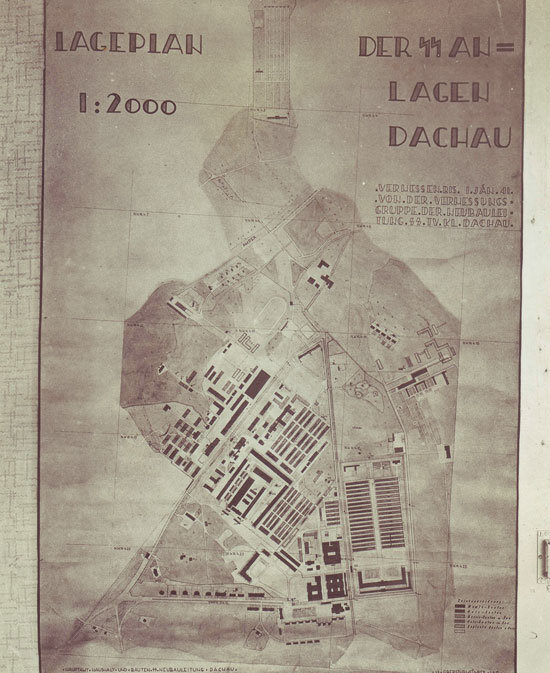
A photograph showing a map of Dachau Concentration Camp, taken upon arrival at the complex by photographer and X-Ray Technician Robert Spring.
The 59th remained in Schnaitheim operating until 3 May 1945, when it officially closed. During this month, V-E Day was also announced, and the remaining patients were not completely evacuated until 19 May. In compliance with the new T/O & E (31 January 1945) a complete reorganization of the unit took place and was completed on 3 May 1945.
1945 Admissions – US Personnel & Allies (Schnaitheim, Germany)
26 April 1945 > 3 May 1945 – 1970 patients (of which 140 battle casualties)
1945 Admissions – German Prisoners of War (Schnaitheim, Germany)
26 April 1945 > 3 May 1945 – 268 patients (of which 183 battle casualties)
On 10 May 1945, the Commanding Officer of the 59th Evacuation Hospital was assigned as Camp Surgeon to the recently-liberated Dachau Concentration Camp. In addition to Col. O. B. Bolibaugh, 10 Officers, the Hospital’s Dietitian and 20 EM were detailed on the staff of the Camp Surgeon. Eight Nurses from the unit were also placed on detached service to work on the typhus ward of the ‘US Army Typhus Commission’ headed by Col. John C. Snyder (which was conducting experimental studies). At Dachau KZ, 11 Wards of 1,200 beds were to be put into operation as soon as possible, and additional American medical units, such as the 10th Field Hospital, the 66th Field Hospital, the 116th Evacuation Hospital and the 127th Evacuation Hospital, arrived to help treat former inmates, Allied ex-Prisoners, enemy PWs, and regular battle casualties.
59th Evacuation Hospital Officers assigned to Dachau Concentration Camp, Germany
(10 May 1945 > 12 June 1945)
Colonel Oral B. Bolibaugh, MC, O-4179 (Commanding Officer & Surgeon)
Lt. Colonel Roy B. Cohn, MC, O-400120 (Executive Officer)
Major John S. Brown, MC, O-400829 (Medical Consultant, Food Advisor, Dietitian)
Major Gilbert A. Bishop, MAC, O-1533259 (Medical Supply Officer)
Captain Nelson C. Bell, MC, O-313454 (Sanitary Officer)
Captain William C. Kuzell; MC, O-447772 (Officer in Charge of Outer Camp Hospital)
Captain William A. Newsom, MC, O-446992 (Chief of Professional Service, Outer Camp Hospital)
Captain Charlton R. Schwartz, MC, O-400122 (Officer in Charge of Outer Camp Dispensary)
Captain John M. Malone, MC, O-474102 (Asst. Chief of Outer Camp Dispensary)
Captain Peter S. Joseph, MC, O-400471 (Officer in Charge of Convalescent Hospital)
Captain Rene Bine, Jr., MC, O-439518 (Officer in Charge of Convalescent Hospital)
1st Lieutenant Henriette H. Dickinson, HD, R-328 (Officer in Charge of Diet Food)
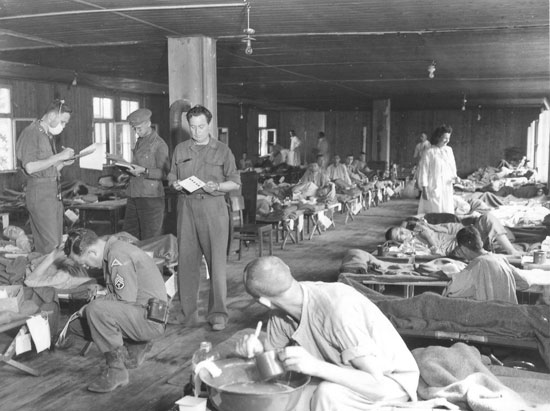
Illustration showing the Typhus Ward which was established by personnel from the 59th Evac Hosp at Dachau, Germany. The Ward has been established using GI Folding Cots and Blankets.
The final stages of WW2 saw the unit stationed in the buildings of the former German Tank School at Ellwangen, Germany. The unit was not operational during this period and a training program was conducted for all personnel not engaged in other organizational activities. Physical condition was the prime concern, and a number of activities ensured it was maintained. Many of the unit’s Officers were withdrawn during the month of August 1945 and transferred to other organizations. By the end of the month, only 5 Officers remained in the unit.
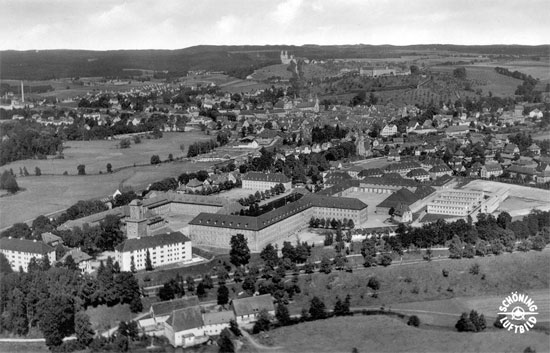
An aerial view of the German Army Tank School situated at Ellwangen, which was used as a temporary station for the remaining personnel of the unit. Activities such as Baseball, Badminton, Volleyball and Swimming were encouraged to maintain fitness.
Photograph courtesy of www.usarmygermany.com
Awards & Statistics:
During its history of WW2, the 59th Evacuation Hospital was awarded the Meritorious Service Unit Award for its service in France (5 October 1944 – 30 December 1944). In addition 9 Enlisted personnel from the unit were awarded the Army Good Conduct Medal for exemplary behavior, efficiency and fidelity. They were as follows:
| M/Sgt Wayne W. Wiley | (ASN 36675935) |
| T/3 Ralph G. Mullen | (ASN 36675997) |
| T/3 Harry Rabinowitz | (ASN 32508770) |
| T/4 Stephen J. Zavodny | (ASN 36167617) |
| Cpl Virgil L. Brown | (ASN 36676295) |
| T/5 Lawrence A Curry | (ASN 32946752) |
| T/5 Joseph F Lake | (ASN 32399402) |
| T/5 Walter R. Stackhouse | (ASN 37487651) |
| Pfc Vernon W. Gittings | (ASN 33726755) |
Hospital Statistics:
The following statistics represent overall figures for the 59th Evacuation Hospital during its continental service in WW2, and cover the time period of 1 May 1942 – 19 May 1945:
Total patient admissions: 40,532
Total Purple Heart patients: 40
The majority of above images are courtesy of Joanne McLaughlin, and belong to the collection of T/5 George P. McLaughlin (ASN:31026229). The photographer is Robert Spring. Additional data were received with thanks from Lynn F. McNulty, son of Captain Frederick J. McNulty (O-526873). We would also like to thank John Sateja, nephew of S/Sgt Charles N. Sateja (ASN:36016716) for kindly providing additional photographs of the 59th Evacuation Hospital during WW2.
